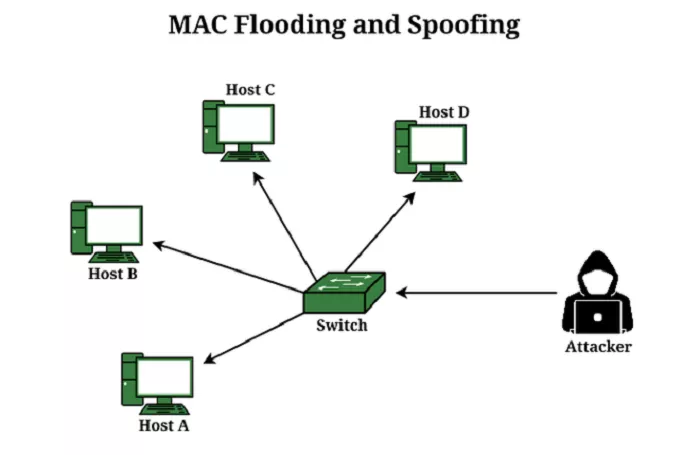In today’s interconnected world, network security is paramount. One technique that poses a significant threat to network integrity is MAC address spoofing. This article provides a comprehensive overview of MAC address spoofing, explaining its mechanisms, purposes, implications, and prevention strategies in simple terms.
What Is a MAC Address?
A Media Access Control (MAC) address is a unique identifier assigned to a network interface controller (NIC) for communications at the data link layer of a network segment. It serves as a hardware address that identifies each device on a network. MAC addresses are typically assigned by the device manufacturer and are stored in the device’s hardware, such as the read-only memory (ROM) or firmware.
Format of a MAC Address
A standard MAC address consists of six groups of two hexadecimal digits, separated by colons or hyphens. For example: 00:1A:2B:3C:4D:5E.
What Is MAC Address Spoofing?
MAC address spoofing refers to the practice of altering the factory-assigned MAC address of a network interface on a device. This change can be achieved through software tools or by modifying system settings, allowing the device to assume a different MAC address.
How Does MAC Spoofing Work?
- Identification: The attacker identifies the MAC address of a legitimate device on the target network.
- Modification: Using specialized software or command-line tools, the attacker changes their device’s MAC address to match the identified legitimate MAC address.
- Access: The network perceives the attacker’s device as the legitimate one, granting it access and potentially allowing it to intercept or manipulate network traffic.
Motivations Behind MAC Address Spoofing
MAC address spoofing can be employed for various reasons, both benign and malicious:
1. Bypassing Network Access Controls
Some networks implement MAC address filtering, allowing only devices with specific MAC addresses to connect. An attacker can spoof a whitelisted MAC address to gain unauthorized access.
2. Anonymity and Privacy
Users may spoof their MAC addresses to maintain anonymity, preventing tracking based on hardware identifiers, especially on public Wi-Fi networks.
3. Circumventing Device Restrictions
Internet Service Providers (ISPs) may restrict service to registered MAC addresses. Spoofing allows users to replace hardware without notifying the ISP or to connect multiple devices under a single registered MAC address.
4. Impersonation for Malicious Activities
Attackers can impersonate trusted devices to intercept sensitive data, conduct man-in-the-middle attacks, or disrupt network services.
Potential Risks and Implications
While MAC spoofing can serve legitimate purposes, it poses significant security risks:
1. Unauthorized Network Access
By mimicking authorized devices, attackers can infiltrate networks, accessing sensitive information or resources.
2. Data Interception
Spoofed devices can intercept data intended for legitimate devices, leading to potential data breaches.
3. Man-in-the-Middle Attacks
Attackers can position themselves between two communicating parties, intercepting and potentially altering the data exchanged.
4. Denial-of-Service (DoS) Attacks
By flooding the network with traffic from spoofed MAC addresses, attackers can overwhelm network resources, causing service disruptions.
Detection and Prevention Strategies
To safeguard networks against MAC address spoofing, several measures can be implemented:
1. Network Access Control (NAC)
Implementing NAC solutions can enforce security policies, ensuring that only authenticated and compliant devices access the network.
2. Port Security
Configuring switches to limit the number of MAC addresses per port and to shut down ports when violations occur can prevent unauthorized access.
3. 802.1X Authentication
This network access control protocol authenticates devices before granting network access, reducing the risk of spoofing.
4. Regular Network Monitoring
Monitoring network traffic for anomalies, such as duplicate MAC addresses or unexpected devices, can help detect spoofing attempts.
5. MAC Address Filtering
While not foolproof, maintaining a whitelist of authorized MAC addresses can deter casual attackers.
6. Encryption and Secure Protocols
Using encrypted communication protocols, like HTTPS and VPNs, can protect data even if a network is compromised.
Legal and Ethical Considerations
While MAC address spoofing can be used for legitimate purposes, such as privacy protection, it can also facilitate illegal activities. Unauthorized access to networks, data theft, and service disruptions are criminal offenses in many jurisdictions. It’s essential to understand the legal implications and to use MAC spoofing responsibly.
Conclusion
MAC address spoofing is a technique that, while offering certain legitimate uses, poses significant security challenges. Understanding how it works, recognizing its potential risks, and implementing robust security measures are crucial steps in protecting networks from unauthorized access and data breaches. By staying informed and vigilant, individuals and organizations can mitigate the threats associated with MAC address spoofing.

